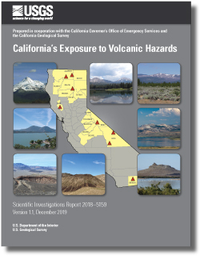California’s Exposure to Volcanic Hazards
Links
- Document: Report (33.6 MB pdf)
- Appendixes:
- Version History: Version History
- Download citation as: RIS | Dublin Core
Abstract
The potential for damaging earthquakes, landslides, floods, tsunamis, and wildfires is widely recognized in California. The same cannot be said for volcanic eruptions, despite the fact that they occur in the state about as frequently as the largest earthquakes on the San Andreas Fault. At least ten eruptions have taken place in the past 1,000 years, and future volcanic eruptions are inevitable.
The U.S. Geological Survey’s (USGS) national volcanic threat assessment identifies eight young volcanic areas in California as moderate, high, or very high threat. Of the eight volcanic areas that exist in California, molten rock resides beneath at least seven of these—Medicine Lake volcano, Mount Shasta, Lassen Volcanic Center, Clear Lake volcanic field, the Long Valley volcanic region, Coso volcanic field, and Salton Buttes—and are therefore considered “active” volcanoes producing volcanic earthquakes, toxic gas emissions, hot springs, geothermal systems, and (or) ground movement.
The USGS California Volcano Observatory in Menlo Park, California, monitors these potentially hazardous volcanoes to help communities and government authorities understand, prepare for, and respond to volcanic activity. Although volcanic activity can sometimes be forecast, eruptions, like earthquakes or tsunamis, cannot be prevented. Understanding the hazards and identifying what and who is in harm’s way is the first step in mitigating volcanic risk and building community resilience to volcanic hazards.
This report, which was prepared in collaboration with the California Governor’s Office of Emergency Services and the California Geological Survey, provides a broad perspective on the state’s exposure to volcanic hazards by integrating volcanic hazard information with geospatial data on at-risk populations, infrastructure, and resources. This information is intended to prompt site- and sector-specific vulnerability analyses and preparation of hazard mitigation and response plans.
Suggested Citation
Mangan, M., Ball, J., Wood, N., Jones, J.L., Peters, J., Abdollahian, N., Dinitz, L., Blankenheim, S., Fenton, J., and Pridmore, C., 2019, California’s exposure to volcanic hazards (ver. 1.1, December 2019): U.S. Geological Survey Scientific Investigations Report 2018–5159, 49 p., https://doi.org/10.3133/sir20185159.
ISSN: 2328-0328 (online)
Study Area
Table of Contents
- Introduction
- Hazards and Impacts
- “Watch List” Volcanoes and Hazard Zones
- Societal Exposure to Volcanic Hazards
- Summary and Next Steps
- Acknowledgments
- References
- Glossary
- Appendixes 1–3
| Publication type | Report |
|---|---|
| Publication Subtype | USGS Numbered Series |
| Title | California’s exposure to volcanic hazards |
| Series title | Scientific Investigations Report |
| Series number | 2018-5159 |
| DOI | 10.3133/sir20185159 |
| Publication Date | February 25, 2019 |
| Year Published | 2019 |
| Language | English |
| Publisher | U.S. Geological Survey |
| Publisher location | Reston, VA |
| Contributing office(s) | Volcano Science Center |
| Description | Report: vi, 49 p.; 2 Appendixes |
| Country | United States |
| State | California |


